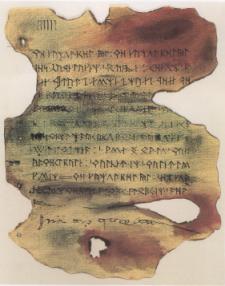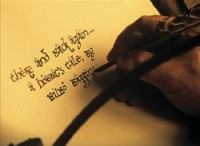

An encyclopedia of Middle-earth and Numenor

|
|
|
|
|
|
|
|
|
|
|
|
|
|
| |
|
 |

An encyclopedia of Middle-earth and Numenor |
 |

The Akallabeth was preserved in the archives of Gondor. It was among the records used by Frodo Baggins and Peregrin Took in compiling the Red Book and the expanded Thain's Book. Modern readers will find a version of the Akallabeth in The Silmarillion.
Names &
Etymology:
The word Akallabêth
means "the Downfallen" in Adunaic, the language of Numenor.
Sources:
Unfinished
Tales: "The Line of Elros: Kings of Numenor," p. 214, 227 note 16;
"Cirion and Eorl," p. 310 note 2
Appendix
A of The Lord of the Rings: "The Numenorean Kings," p. 315
The Lord
of the Rings: A Reader's Companion by Wayne G. Hammond and Christina
Scull: "Appendix A," p. 682
The Silmarillion:
"Akallabeth," passim
The leaves were long, the grass was green,The song is in iambic tetrameter, meaning each line is composed of four sets of alternating short and long (or unstressed and stressed) syllables. This appears to be the key characteristic of the ann-thennath. The rhyme scheme of this particular song is ABAC BABC, though it is not clear whether this applies to all songs and poems written in this form.
The hemlock-umbels tall and fair,
And in the glade a light was seen
Of stars in shadow shimmering.
Tinuviel was dancing there
To music of a pipe unseen,
And light of stars was in her hair,
And in her raiment glimmering.
The Fellowship of the Ring: "A Knife in the Dark," p. 204
It should be noted that this is meant to be a Common Speech translation of the song from the original Sindarin, though no Elvish version exists among Tolkien's writings.
Names &
Etymology:
The word ann-thennath may
be translated as "long-shorts" or "longs and shorts" from the Sindarin
ann
meaning "long" and then meaning "short" and the collective plural
ending
-ath.
Sources:
The Fellowship
of the Ring: "A Knife in the Dark," p. 204-205
The Lord
of the Rings: A Reader's Companion by Wayne G. Hammond and Christina
Scull: "A Knife in the Dark," p. 174-75
The History
of Middle-earth, vol. V, The Lost Road and Other Writings: "The Etymologies,"
entries for ANAD, ANDA and STINTA
Tolkien's
Legendarium: Essays on the History of Middle-earth: "Three Elvish Verse
Modes" by Patrick Wynne and Carl F. Hostetter
Gateway
to Sindarin by David Salo: "Sindarin Names," p. 359
"The Rivers
and Beacon-hills of Gondor," by J.R.R. Tolkien, edited by Carl F. Hostetter,
commentary by Christopher Tolkien, in Vinyar Tengwar #42, July 2001,
p. 15, 29 note 35 (then = "short")
Book of Mazarbul |
Page
from the Book of Mazarbul by J.R.R. Tolkien
|
 Record
of Balin's expedition to Moria.
The Book of Mazarbul covered five years, beginning with the arrival
of the Dwarves in Moria in 2989 of the Third Age and abruptly ending in
the year 2994. It was written in many different hands using the runes of
Moria and Dale as well as Elvish letters.
Record
of Balin's expedition to Moria.
The Book of Mazarbul covered five years, beginning with the arrival
of the Dwarves in Moria in 2989 of the Third Age and abruptly ending in
the year 2994. It was written in many different hands using the runes of
Moria and Dale as well as Elvish letters.
The book chronicled the hardships encountered by the Dwarves as they tried to retake Moria from the Orcs and other creatures that inhabited the dark caverns. The deaths of many of their company including Balin were recorded. The last entry was written in Elvish script by Ori:
We cannot get out. We cannot get out. They have taken the Bridge and second hall. Frár and Lóni and Náli fell there ... went 5 days ago ... the pool is up to the wall at Westgate. The Watcher in the Water took Óin. We cannot get out. The end comes ... drums, drums in the deep ... they are coming.When the Fellowship came to the Chamber of Mazarbul in Moria on January 15, 3019, Gandalf discovered the Book of Mazarbul. It had been battered and burned and slashed and a number of pages were defaced or missing, but Gandalf was able to piece together the Dwarves' tragic story. After he read the last pages, the Fellowship heard drums in the deep and they were attacked by Orcs.
The Fellowship of the Ring: "The Bridge of Khazad-dum," p. 336
The Book of Mazarbul was given to Gimli to be passed on to King Dain II, however Dain died in the Battle of Dale before Gimli was able to do so. The Book may have been given to Dain's heir Thorin III.
Names &
Etymology:
Mazarbul means "records"
in Dwarvish.
Source:
The Fellowship
of the Ring: "The Bridge of Khazad-dum," p. 335-37
Sources:
The Fellowship
of the Ring: "Prologue: Concerning Pipe-weed," p. 17; "Prologue: Note
on the Shire Records," p. 24
Source:
The Fellowship
of the Ring: "Prologue: Note on the Shire Records," p. 24
Source:
The Fellowship
of the Ring: "Prologue: Note on the Shire Records," p. 24
Red Book of Westmarch |
Bilbo
writing his tale from the New Line
Cinema film
|
 The
Red Book was written by Bilbo and Frodo
Baggins and completed by Sam Gamgee. It tells
of their adventures in the Third Age of Middle-earth and is the primary
source of information on Hobbits and their role in the War
of the Ring.
The
Red Book was written by Bilbo and Frodo
Baggins and completed by Sam Gamgee. It tells
of their adventures in the Third Age of Middle-earth and is the primary
source of information on Hobbits and their role in the War
of the Ring.
Bilbo began writing his memoirs, which he called There and Back Again: A Hobbit's Holiday, sometime after he returned from his journey with the Dwarves to the Lonely Mountain in 2941 of the Third Age. It was not yet completed when he left the Shire in 3001. He took the manuscript with him in hopes of finding a quiet place to finish it. He planned to end his book with: "and he lived happily ever after to the end of his days." (FotR, p. 41)
After Bilbo settled in Rivendell in 3002, he wrote many songs and poems and began work on his Translations from the Elvish which relate the history of the Elder Days. He does not seem to have finished his memoirs, however, though he told Frodo that he had done some more work on them. As it turned out, Frodo would have quite a bit more to add to the tale.
When Frodo stopped at Rivendell after his quest in 3019, he collected Bilbo's manuscript and notes along with the three red-bound volumes of Translations from the Elvish. During his last years in the Shire, Frodo organized Bilbo's manuscript and added to it his account the War of the Ring. It was bound in red leather, and the title page read as follows (with a number of titles crossed out):
My Diary. My Unexpected Journey. There and Back Again. And What Happened After.Frodo had completed up through chapter 80, but that chapter he left for Sam to complete.
Adventures of Five Hobbits. The Tale of the Great Ring, compiled by Bilbo Baggins from his own observations and the accounts of his friends. What we did in the War of the Ring.
[Here Bilbo's hand ended and Frodo had written:]THE DOWNFALL
OF THE
LORD OF THE RINGS
AND THE
RETURN OF THE KING
(as seen by the Little People; being the memoirs of Bilbo and Frodo of the Shire,
supplemented by the accounts of their friends and the learning of the Wise.)
Together with extracts from Books of Lore translated by Bilbo in Rivendell.
In the year 61 of the Fourth Age, Sam departed for the Grey Havens and left The Red Book with his eldest daughter Elanor, who lived at Undertowers in the Westmarch, a land on the western border of the Shire. The book was kept in a red case along with the three-volume Translations from the Elvish and a fifth volume of genealogical tables and commentaries. It was passed down through the generations of her family, the Fairbairns, and though the original has not survived, many copies were made, the most important of which was The Thain's Book.
Names &
Etymology:
Also called the Red Book of the
Periannath (Hobbits).
Sources:
The Hobbit:
"The Last Stage," p. 316
The Fellowship
of the Ring: "Prologue: Note on the Shire Records," p. 23-24; "A Long-Expected
Party," p. 40-41; "Many Meetings," p. 243
The Return
of the King: "Many Partings," p. 265-6; "The Grey Havens," p. 307
Appendix
B of The Lord of the Rings: "The Tale of Years," p. 378
Source:
The Return
of the King: "The Scouring of the Shire," p. 295
The Tale of Aragorn and ArwenThe story of the meeting and courtship of Aragorn and Arwen and their life together. The complete tale was written by Faramir's grandson Barahir after Aragorn's death. An abbreviated version of the tale was included in the copy of The Thain's Book made by Findegil in 172 of the Fourth Age.The story tells of Aragorn's first meeting with Arwen at Rivendell and of their later meeting in Lothlorien, where Arwen chose a mortal life and pledged her love to Aragorn. It also tells of Aragorn's death in 120 of the Fourth Age and of Arwen's death a year later. The short version of The Tale of Aragorn and Arwen can be found in Appendix A of The Lord of the Rings. Sources:
|
Arwen
and Aragorn
in the New Line film  |
Source:
The Fellowship
of the Ring: "Prologue: Note on the Shire Records," p. 24-25
Peregrin Took brought a copy of The Red Book to Gondor in the year 64 of the Fourth Age. At the request of Aragorn, King Elessar, a copy was made with many annotations, additions, and corrections. In particular, names, words, and Elvish quotations were verified and corrected as needed. One addition was an abbreviated version of The Tale of Aragorn and Arwen, the full account of which was written by Barahir, grandson of Faramir, after Aragorn's death. Another was a history of the Dwarves entitled Durin's Folk based on information provided by Gimli.
In 172 of the Fourth Age, Findegil, King's Writer, finished a fair copy of The Thain's Book in Minas Tirith. This copy was the only one to include Bilbo's complete Translations from the Elvish, a history of the Elder Days which he compiled while at Rivendell between 3003 and 3018 of the Third Age. The copy was most likely made at the request of Peregrin Took's great-grandson. It was brought to the Shire and was kept at the Great Smials, the ancestral home of the Tooks in Tuckborough.
Portions of The Thain's Book are available to modern readers. The Hobbit and The Lord of the Rings are derived from the original Red Book. These tell the story of the finding of the One Ring and the quest to destroy it. The Appendices found at the end of The Lord of the Rings contain material that was added to The Thain's Book in Minas Tirith, such as The Tale of Aragorn and Arwen. The Silmarillion is a compiled from Bilbo's Translations from the Elvish.
Sources:
The Fellowship
of the Ring: "Prologue: Note on the Shire Records," p. 23-24
Appendix
A of The Lord of the Rings: "Annals of the Kings and Rulers," p. 313
Bilbo gave the books to Frodo Baggins when Frodo passed through Rivendell on his way home to the Shire in 3019. When Frodo left Middle-earth in 3021, he gave Bilbo's Translations from the Elvish to Sam Gamgee along with the history of the finding and the destruction of the One Ring that came to be known as The Red Book of Westmarch. The books were passed to Sam's daughter Elanor and were kept together in a red case at her home in the Westmarch.
In 172 of the Fourth Age, a copy of the Red Book and the Translations from the Elvish was made by Findegil, a scribe in Gondor. This copy, known as The Thain's Book, was brought back to the Shire and was kept in the library at the Great Smials.
Modern readers can find portions of Bilbo's Translations from the Elvish in The Silmarillion.
Sources:
The Fellowship
of the Ring: "Prologue: Note on the Shire Records," p. 23-24
The Return
of the King: "Many Partings," p. 265-6; "The Grey Havens," p. 307
Appendix
B of The Lord of the Rings: "The Tale of Years," p. 378
Names &
Etymology:
Also called the Great Writ of
Tuckborough and the Yellowskin.
Sources:
Appendix
D of The Lord of the Rings: "The Calendars," p. 389
The History
of Middle-earth, vol. XII, The Peoples of Middle-earth: "The Appendix
on Languages," p. 40
All entries are Copyright © by the Thain from former tuckborough.net. Please contact me if you are Thain or know anything about how to contact the original author.
2003-2011, The Thain's Book - thainsbook.minastirith.cz
- e-mail: thain at tuckborough.net